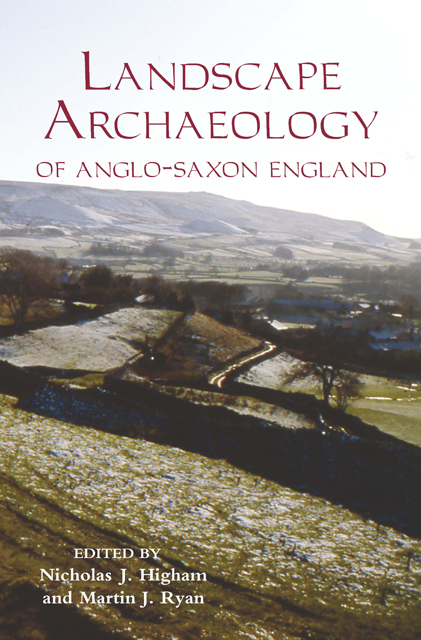Book contents
- Frontmatter
- Contents
- List of Illustrations
- Contributors
- Acknowledgements
- Abbreviations
- 1 The Landscape Archaeology of Anglo-Saxon England: An Introduction
- 2 Barriers to Knowledge: Coppicing and Landscape Usage in the Anglo-Saxon Economy
- 3 Landscape Change during the ‘Long Eighth Century’ in Southern England
- 4 Population Ecology and Multiple Estate Formation: The Evidence from Eastern Kent
- 5 Exploring Black Holes: Recent Investigations in Currently Occupied Rural Settlements in Eastern England
- 6 Medieval Field Systems and Settlement Nucleation: Common or Separate Origins?
- 7 The Environmental Contexts of Anglo-Saxon Settlement
- 8 Calendar Illustration in Anglo-Saxon England: Realities and Fictions of the Anglo-Saxon Landscape
- 9 The Anglo-Saxon Plough: A Detail of the Wheels
- 10 ‘In the Sweat of thy Brow Shalt thou eat Bread’: Cereals and Cereal Production in the Anglo-Saxon Landscape
- 11 The Early Christian Landscape of East Anglia
- 12 The Landscape and Economy of the Anglo-Saxon Coast: New Archaeological Evidence
- Index
12 - The Landscape and Economy of the Anglo-Saxon Coast: New Archaeological Evidence
Published online by Cambridge University Press: 16 February 2023
- Frontmatter
- Contents
- List of Illustrations
- Contributors
- Acknowledgements
- Abbreviations
- 1 The Landscape Archaeology of Anglo-Saxon England: An Introduction
- 2 Barriers to Knowledge: Coppicing and Landscape Usage in the Anglo-Saxon Economy
- 3 Landscape Change during the ‘Long Eighth Century’ in Southern England
- 4 Population Ecology and Multiple Estate Formation: The Evidence from Eastern Kent
- 5 Exploring Black Holes: Recent Investigations in Currently Occupied Rural Settlements in Eastern England
- 6 Medieval Field Systems and Settlement Nucleation: Common or Separate Origins?
- 7 The Environmental Contexts of Anglo-Saxon Settlement
- 8 Calendar Illustration in Anglo-Saxon England: Realities and Fictions of the Anglo-Saxon Landscape
- 9 The Anglo-Saxon Plough: A Detail of the Wheels
- 10 ‘In the Sweat of thy Brow Shalt thou eat Bread’: Cereals and Cereal Production in the Anglo-Saxon Landscape
- 11 The Early Christian Landscape of East Anglia
- 12 The Landscape and Economy of the Anglo-Saxon Coast: New Archaeological Evidence
- Index
Summary
Stephen Rippon has provided a helpful framework within which to consider land-use in coastal wetlands during the first millennium AD. He distinguishes three types of land-use. Exploitation was simply making use of the available resources: salt itself, saltmarsh grazing, fisheries, wildfowl, sub-surface peat, and constructional materials. Modification involved increasing productivity and utility, primarily by controlling water, by drainage and limited embankment of grazing and settlement areas. Transformation – the construction of sea-walls to exclude tidal waters, with permanent drainage systems landwards, and conversion of the former intertidal zone to grazing and arable – marked a fundamental disjunction with previous land-use. The landscape was changed (it was thought) permanently, in a high-risk, high-cost but also high-return strategy.
There was never anything inevitable nor necessarily sequential about shifts from one of these forms of land-use to another: each represented an appropriate adaptation of human behaviour to prevailing circumstances in particular places. However, land-use in the second millennium AD tended towards transformation wherever that could be achieved, reaching its furthest extent in the nineteenth century. Indeed, some land-claim seems to have been undertaken then without very much thought, simply because agricultural ‘improvement’ was beyond question. The defence of reclaimed land was likewise scarcely questioned, well into the twentieth century. Formal economic appraisal to consider the value of the land defended in relation to the costs of its maintenance did not then figure.
In the first decade of the third millennium, the appropriate use of coastal wetlands is being reappraised, again in the light of changing circumstances. The criteria now being applied differ: coastal land-use is no longer the exclusive pre- serve of private owners hoping for profit. State direction of what is now called Flood and Coastal Erosion Risk Management (FCERM) leads to other priorities, such as conservation of natural habitats (driven by the EU Species, Birds and Habitats Directives), and longer-term economic considerations about climate change and the sustainability of coasts. The earlier paradigm – in which landclaim to increase agricultural productivity was seen as the natural and obvious course of action, and reclaimed land was considered to be claimed for ever – has now been abandoned. In turn, coastal policy options such as ‘managed realignment’ or ‘no active intervention’ are already having adverse effects on coastal archaeological sites and the wider historic environment.
- Type
- Chapter
- Information
- The Landscape Archaeology of Anglo-Saxon England , pp. 211 - 222Publisher: Boydell & BrewerPrint publication year: 2010
- 2
- Cited by

